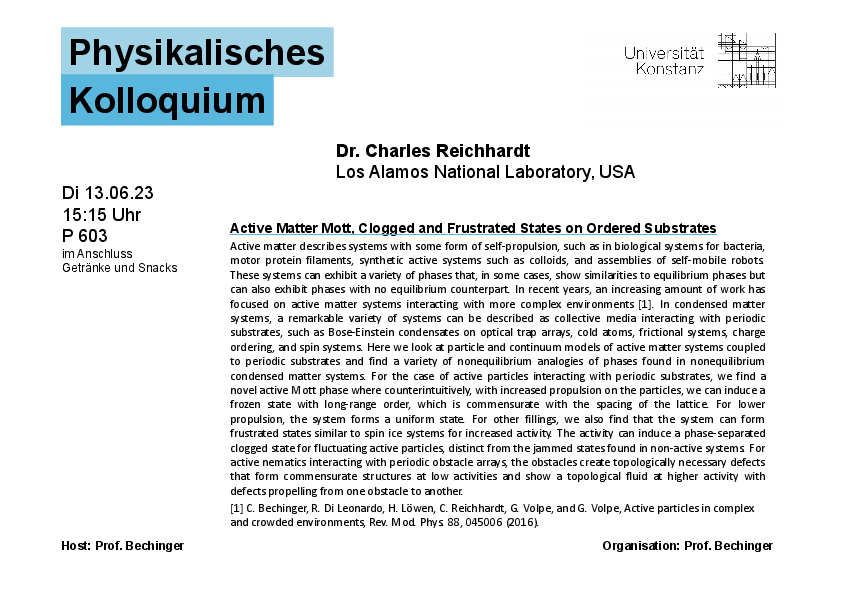Physics Colloquium: Active Matter Mott, Clogged and Frustrated States on Ordered Substrates
Time
Tuesday, 13. June 2023
15:15 - 16:45
Location
P 603 followed by refreshments and snacks
Organizer
FB Physik / Prof. Clemens Bechinger
Speaker:
Dr. Charles Reichhardt - Los Alamos National Laboratory, USA
Active matter describes systems with some form of self‐propulsion, such as in biological systems for bacteria, motor protein filaments, synthetic active systems such as colloids, and assemblies of self‐mobile robots. These systems can exhibit a variety of phases that, in some cases, show similarities to equilibrium phases but can also exhibit phases with no equilibrium counterpart. In recent years, an increasing amount of work has focused on active matter systems interacting with more complex environments [1]. In condensed matter systems, a remarkable variety of systems can be described as collective media interacting with periodic substrates, such as Bose‐Einstein condensates on optical trap arrays, cold atoms, frictional systems, charge ordering, and spin systems. Here we look at particle and continuum models of active matter systems coupled to periodic substrates and find a variety of nonequilibrium analogies of phases found in nonequilibrium condensed matter systems. For the case of active particles interacting with periodic substrates, we find a novel active Mott phase where counterintuitively, with increased propulsion on the particles, we can induce a frozen state with long‐range order, which is commensurate with the spacing of the lattice. For lower propulsion, the system forms a uniform state. For other fillings, we also find that the system can form frustrated states similar to spin ice systems for increased activity. The activity can induce a phase‐separated clogged state for fluctuating active particles, distinct from the jammed states found in non‐active systems. For active nematics interacting with periodic obstacle arrays, the obstacles create topologically necessary defects that form commensurate structures at low activities and show a topological fluid at higher activity with defects propelling from one obstacle to another.
[1] C. Bechinger, R. Di Leonardo, H. Löwen, C. Reichhardt, G. Volpe, and G. Volpe, Active particles in complex and crowded environments, Rev. Mod. Phys. 88, 045006 (2016).

